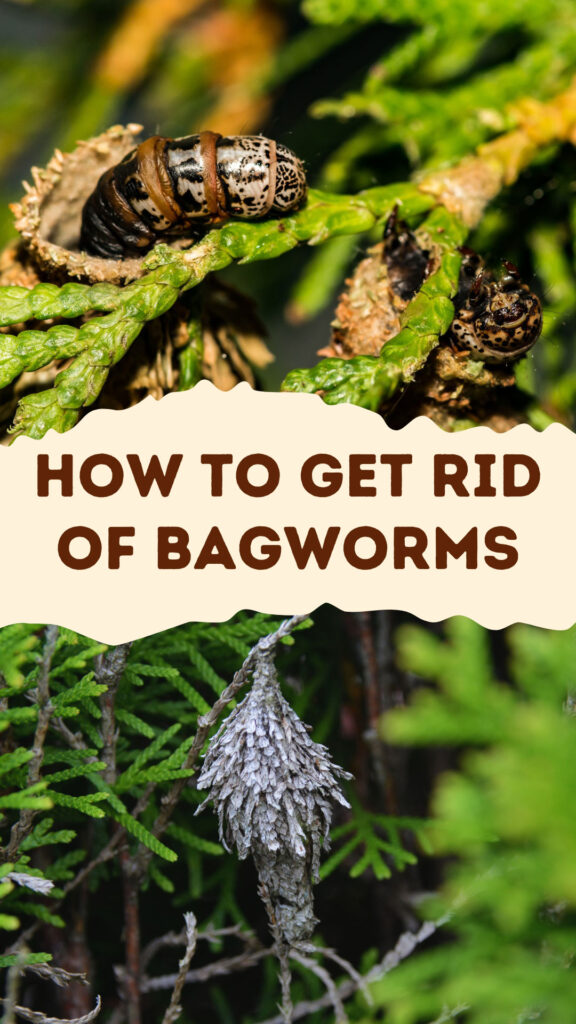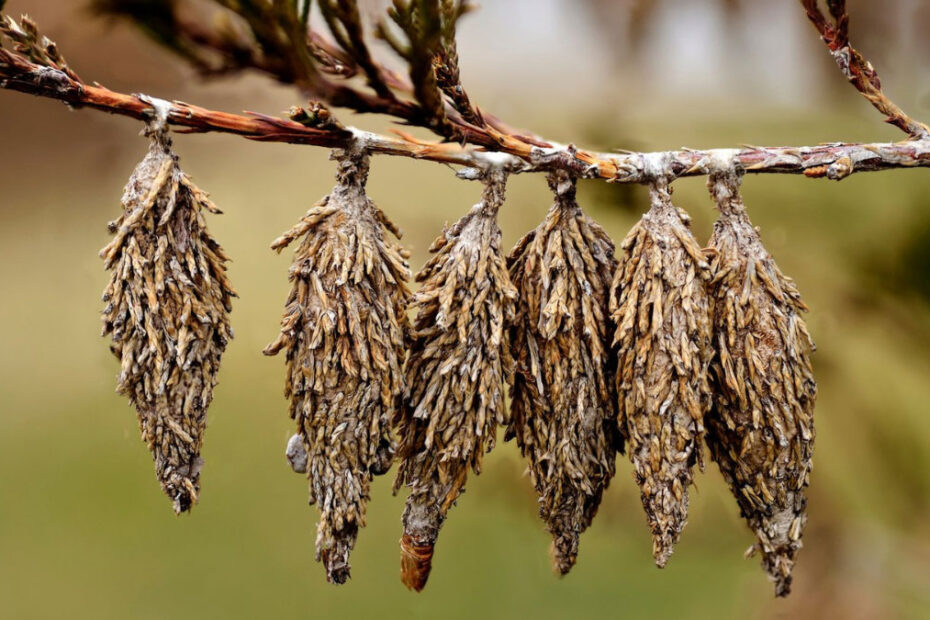Bagworms can wreak havoc on your garden, turning lush greenery into a barren wasteland. These pesky caterpillars encase themselves in protective bags made from plant material, making them difficult to spot and even harder to eliminate. If you’ve noticed unsightly brown bags hanging from your trees and shrubs, it’s time to take action.
Understanding how to get rid of bagworms effectively is crucial for maintaining the health of your plants. With the right approach, you can protect your garden from these destructive pests and ensure your greenery thrives. Let’s jump into some proven strategies to help you reclaim your outdoor space from bagworms.
Key Takeaways
- Early Detection is Crucial: Regularly inspect your garden, especially evergreen trees and shrubs, for signs of bagworm infestations such as cocoon-like bags and foliage damage.
- Manual Removal: Handpick and destroy bagworm bags during late fall, winter, or early spring when they are dormant to reduce their population.
- Natural Methods: Introduce beneficial insects like Trichogramma wasps and Tachinid flies to your garden to naturally manage bagworm populations.
- Chemical Treatments: Use insecticides like Bacillus thuringiensis (Bt), Spinosad, Carbaryl, and Permethrin during the larval stage for effective control, following safety precautions.
- Preventive Measures: Maintain plant health through regular pruning, adequate watering, balanced fertilization, and debris removal to minimize future infestations.

Understanding Bagworms
Bagworms (Psychidae) inflict significant damage on gardens. These larvae use plant material to construct protective cases, making them elusive. Recognizing and understanding their lifecycle and behavior aids in their management and control.
Lifecycle
- Eggs: Bagworms lay eggs within the femaleâs case.
- Larvae: After hatching, larvae feed on nearby plant foliage.
- Pupation: Larvae pupate in their bags.
- Adults: Males emerge to mate, females remain in their cases.
Behavior
- Feeding Habits: They consume leaves, causing defoliation.
- Bag Movement: While feeding, larvae move their bags to new locations.
- Plant Preference: They target a variety of plants, but evergreen trees and shrubs are most susceptible.
Key Terms
- Defoliation: The process of leaves being stripped off a plant.
- Pupation: The stage in an insect’s life cycle when it transforms from larva to adult.
Identifiable Signs
- Brown Bags: Noticeable on branches, bags blend with plant material.
- Leaf Damage: Holes or missing portions in leaves indicate feeding.
- Silk Strands: Fine silk might anchor the bags to plants.
- Regular Inspection: Frequently check plants, especially evergreens.
- Manual Removal: Handpick and destroy bags during the winter.
- Insecticides: Use appropriate insecticides, particularly during the larval stage.
Understand bagworms’ destructive potential to effectively protect your garden. Regular monitoring ensures early detection and timely intervention.
Identifying Bagworm Infestations
Detecting bagworm infestations early is critical for mitigating their damage to your plants. Recognizing signs and understanding which plants are most vulnerable can help you maintain a healthy garden.
Signs of Bagworm Presence
Bagworms can be identified by distinct signs. These indications verify the presence of these pests in your garden:
- Cocoon-like Bags: Bagworms create protective bags from silk and plant material. These bags, which can be up to 2 inches long, are often seen hanging from branches. They blend in with the foliage, making them hard to spot.
- Foliage Damage: You may notice defoliation or missing leaves on affected plants. Bagworms feed voraciously, leading to significant leaf loss, especially in evergreen trees.
- Silk Strands: Look for fine silk strands on branches and leaves. The larvae use silk to create their bags and secure them to plants.
Commonly Affected Plants
Bagworms prefer certain plants. Understanding which plants are at risk helps in early detection and prevention:
- Evergreen Trees: Spruce, cedar, juniper, and pine trees are highly susceptible. Bagworm activity often leads to significant defoliation in these species.
- Deciduous Trees: Trees like maple, sycamore, and birch can also be affected, though to a lesser extent than evergreens.
- Shrubs: Arborvitae and other ornamental shrubs are common targets for bagworm infestations.
Proactively monitoring these plants, especially during the spring and summer months, ensures that you detect and address bagworm issues promptly. This vigilance is essential in protecting your garden from potential damage.
Natural Methods for Bagworm Control
Achieve effective and eco-friendly bagworm control through natural methods. Employing these strategies ensures your garden remains safe for beneficial organisms while efficiently managing bagworm populations.
Manual Removal
Remove bagworms manually to reduce their numbers significantly. This method is labor-intensive but effective if executed correctly. Perform manual removal during late fall, winter, or early spring when bagworms are dormant.
Steps for Manual Removal:
- Inspect: Regularly check all trees, shrubs, and plants, especially those previously infested.
- Remove: Pluck the bags off the branches. Wear gloves to protect your hands.
- Dispose: Destroy the collected bags. Place them in a sealed plastic bag or burn them to prevent re-infestation.
Beneficial Insects
Introduce beneficial insects to your garden, as they naturally prey on bagworms. This biological control method is safe, sustainable, and part of integrated pest management.
Key Beneficial Insects:
- Trichogramma Wasps: Parasitic wasps that lay eggs inside bagworm eggs, preventing them from hatching.
- Tachinid Flies: These flies deposit eggs on bagworms, and the emerging larvae consume the bagworms from within.
- Acquire: Purchase beneficial insects from reputable suppliers.
- Release: Introduce them during the early stages of bagworm infestation for maximum effectiveness.
- Monitor: Observe their impact and adjust numbers as needed to maintain control.
Use these natural methods to keep your garden healthy and vibrant without harming the environment.
Chemical Treatments
Chemical treatments provide an effective solution for managing bagworm infestations, particularly when natural and manual methods prove insufficient. Targeting the larval stage ensures maximum impact and minimizes damage to your plants.
Insecticides to Use
Several insecticides are effective against bagworms. Selecting the right one and applying it accurately is crucial for success.
Common Insecticides:
- Bacillus thuringiensis (Bt): A natural bacterium impacting young larvae. Safe for beneficial insects and humans.
- Spinosad: Derived from soil bacteria. Effective against various pests with a low impact on non-target organisms.
- Carbaryl: A synthetic insecticide with broad-spectrum action. Suitable for severe infestations but impacts beneficial insects.
- Permethrin: A synthetic pyrethroid providing quick knockdown. Effective on contact but can harm beneficial insects if not used properly.
Application Tips:
- Spray early in the season when larvae are small and actively feeding.
- Cover all foliage, especially where bags are visible.
- Reapply according to the product label, usually every 7-14 days.
Safety Precautions
Using chemical treatments requires adherence to safety guidelines to protect yourself, others, and the environment.
Personal Safety:
- Protective Gear: Wear gloves, long sleeves, and eye protection.
- Ventilation: Apply insecticides outdoors or in well-ventilated areas.
- Clean-Up: Wash hands and any exposed skin immediately after application.
- Weather Conditions: Avoid application on windy days to prevent drift.
- Water Sources: Keep away from ponds, streams, and other water sources to prevent contamination.
- Storage: Store insecticides in their original containers out of children’s and pets’ reach.
Chemical treatments can be an effective part of your bagworm management strategy. Always follow the product label instructions and consider integrating these treatments with natural methods for a balanced approach.
Preventing Future Infestations
Preventing future infestations of bagworms is crucial to maintaining a healthy garden. By taking proactive measures, you can minimize the risk of recurring bagworm problems.
Regular Monitoring
Regular monitoring is essential for early detection of bagworm infestations. Frequent inspections help identify and address issues before they become severe.
- Inspect Plants Frequently: Regularly examine foliage, branches, and stems for signs of bagworms, especially during spring and summer. Look for small, cocoon-like bags hanging from the branches, which indicate the presence of bagworms.
- Check High-Risk Areas: Pay special attention to evergreen trees (such as spruce, cedar, and juniper) and commonly affected deciduous trees (like maple, sycamore, and birch). These plants are more susceptible to bagworm infestations.
- Use a Magnifying Glass: For more precise detection, a magnifying glass can help you spot small bagworms and eggs that are otherwise difficult to see.
- Record Observations: Keep a log of your findings, noting the location, date, and severity of any detected bagworm activity. This helps track patterns and determine the best times for intervention.
Proper Plant Maintenance
Maintaining healthy plants reduces vulnerability to bagworm infestations. Proper care and maintenance create a less favorable environment for these pests.
- Prune Regularly: Remove dead or diseased branches and foliage promptly. Pruning improves air circulation and light penetration, making it harder for bagworms to establish themselves.
- Water Adequately: Ensure plants receive sufficient water, especially during drought periods. Healthy, well-watered plants are more resilient against pests.
- Fertilize Appropriately: Use balanced fertilizers to promote robust plant growth. Healthy plants can better withstand minor pest infestations.
- Remove Debris: Clear fallen leaves, twigs, and other plant debris from around your garden. Bagworms can use this material to construct their protective bags.
- Apply Mulch: A layer of mulch around the base of plants helps retain moisture and regulate soil temperature, contributing to overall plant health.
By implementing these proactive measures, you significantly reduce the likelihood of future bagworm infestations and ensure your garden remains vibrant and healthy.
Conclusion
Successfully managing bagworms requires a combination of proactive monitoring manual removal beneficial insects and chemical treatments. By understanding the lifecycle and identifying signs early you can take timely action to protect your garden. Regular inspections and maintaining plant health are crucial in preventing future infestations. Carry out these strategies and your garden will thrive free from the threat of bagworms.
Frequently Asked Questions
What are bagworms and why are they harmful to gardens?
Bagworms are caterpillars that create protective bags from plant material. They can significantlly damage plants, especially evergreens, by feeding on their foliage and causing defoliation.
How can I identify a bagworm infestation?
Look for cocoon-like bags on branches, leaf damage, and silk strands. Regularly inspecting your plants can help in early detection.
Which plants are most affected by bagworms?
Bagworms commonly affect evergreen trees (like spruce, cedar, juniper, and pine), deciduous trees (such as maple, sycamore, and birch), and ornamental shrubs such as arborvitae.
What are some effective methods to remove bagworms manually?
Manual removal can be done during their dormant periods in late fall, winter, or early spring. Simply pick the bags off the branches and destroy them to prevent future infestations.
Can beneficial insects help control bagworm populations?
Yes, introducing beneficial insects like Trichogramma wasps and Tachinid flies can help control bagworm populations naturally without harming other beneficial organisms.
When should chemical treatments be used to manage bagworms?
Chemical treatments should be considered when manual and natural methods are insufficient. Use insecticides like Bacillus thuringiensis (Bt), Spinosad, Carbaryl, or Permethrin for effective results.
What precautions should be taken when using insecticides against bagworms?
Wear protective gear, ensure proper ventilation, and avoid using insecticides near water sources to prevent contamination and ensure safety.
How can I prevent future infestations of bagworms?
Regularly inspect plants, especially during spring and summer. Maintain plant health through pruning, adequate watering, proper fertilization, debris removal, and applying mulch to create an environment less favorable to bagworms.
